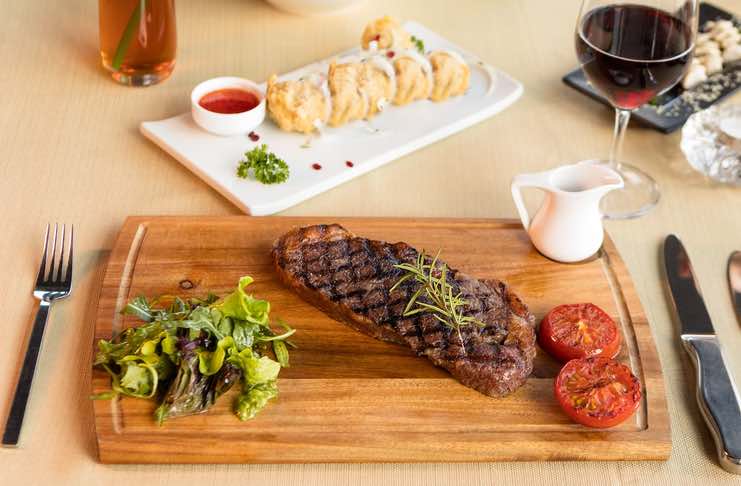Oven-roasting beef is an absolute joy. It’s a versatile type of meat that can go with a huge variety of accompaniments and a huge number of different flavors. Personally, I love it straight up, seasoned generously with salt and pepper, with a rich red wine gravy, served pink in the middle. You just can’t beat it. Various cuts work great, but what follows is a selection of the top 5 tastiest cuts of beef you can cook in an oven.
Tips For Cooking Beef in the Oven
The most important thing that you can do for your beef is to pay attention to the cut that you are working with. Each one has a set of nuances that need to have attention paid to them. In general, however, these are some top tips:
- Don’t hold back on the seasoning. Beef can take salt and pepper generously.
- If you’re working with a lean cut, make sure to tenderize it first to make up for the lack of marbling.
- If your cut appears to have lots of sinews, be sure to remove it first.
- For that deep umami flavoring, be sure to sear the beef all over before roasting.
- Low and slow will always come out better than a high and quick cook.
- Be sure to allow plenty of time for the beef to rest before cooking, this results in a more tender and juicy meal.
Top 5 Tastiest Cuts of Beef to Cook in an Oven
If you’re looking for cuts of beef that pack a flavor with all the convenience of oven cooking, this is the list for you. They come from various cuts of the cow, each is great in its own right and it really comes down to personal preference and how you like to enjoy your beef.
Ribeye Roast
Of all these beautiful roasts on the list, this is my personal favorite. I just love a ribeye roast, as much as I love a steak of the same ilk. Personally, I love the deep, rich marbling that you find in a ribeye. It gives the meat another level of succulence that’s often missing in other cuts. If flavor is what you’re after, then the fat in the marbling is where you’ll find it.
The ribeye cut, as you might expect, comes from the rib section of the beef, many roasts come on the bone but you won’t find any bones within the cut itself. If you’re going for one of these as the centerpiece of your table, ask your butcher to clean up the protruding bones for the best aesthetic.
Tri Tip
Coming from the lower section of the sirloin area (the top of the cow’s back), the roast gets its name from the recognizable triangular shape. There’s still an element of marbling through the meat here, but significantly less than you might find on a rib eye. Essentially, imagine a much, much thicker sirloin steak that tapers to the end and you’ve got a tri tip.
Due to the fatty top that a tri tip has, you’ll need to be sure that the temperature is high enough to give it a crisp, but not so high that the meat dries out (remember there’s not much marbling to keep it moist).
Cooking tri tip in the oven isn’t too difficult. Using a meat thermometer will ensure the perfect roast, I wouldn’t go much higher than an internal temperature of 145° Fahrenheit.
Tenderloin Roast
Otherwise known as the Chateaubriand, this is an exquisite cut of beef that needs to be cared for, nurtured and gently roasted. It’s an expensive cut, much like a fillet steak, and can be treated similarly.
I might have been a bit over the top in my description of the tenderloin’s requirements, as all it needs is seasoning and careful cookery. Best served as pink as you can bear.
Prime Rib Roast
Similar to the ribeye, this is another cut that will suit you down to the ground if you’re a steak lover. The marbling throughout delivers a punch of flavor that you’ll love alongside your roasted accompaniments.
Pair with a powerful sauce as this cut can stand up to a great deal of flavor and seasoning. To get a good sear on the outside you’ll just need a hot pan and a good dusting of salt and pepper. Make sure the salt is the flakey kind for the best results.
If you’re buying your prime rib from the butcher make sure to ask for a three-bone rib roast, from the chuck end (not the loin if you want proper flavor) and ask them to leave the bone in.
Top Round Roast
A joint from the leg area, this is a very lean cut of meat with barely any marbling at all. You’ll need to keep a careful eye on cooking temperatures to ensure that it doesn’t dry out.
If you like your meat well done then I would avoid a top round. The top round can also be somewhat less tender than its ribeye counterparts, therefore you might want to consider tenderizing it in advance of cooking or marinating beforehand.
Key Takeaways
There are, of course, other cuts that you might want to experiment with, but trust me when I say that these are tried, tested, and will be absolutely delicious. Just before you start cooking, refer yourself back to the tips at the start of the article for a stress-free, delicious cook.
- Beef should be served with some pinkness in the middle, it’ll be more tender and taste far better than well-cooked joints.
- Don’t be shy with the seasoning when preparing the beef.
Want to read more of our latest posts? Check out our favorite places to get Ice Cream in New York city.
